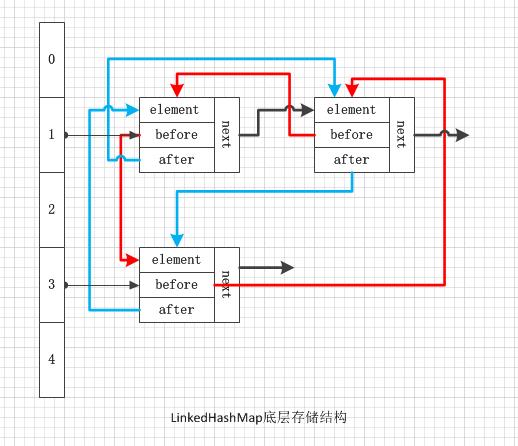LinkedHashMap源码
Posted
tags:
篇首语:本文由小常识网(cha138.com)小编为大家整理,主要介绍了LinkedHashMap源码相关的知识,希望对你有一定的参考价值。
前面分析了HashMap的实现,我们知道其底层数据存储是一个hash表(数组+单向链表)。接下来我们看一下另一个LinkedHashMap,它是HashMap的一个子类,他在HashMap的基础上维持了一个双向链表(hash表+双向链表),在遍历的时候可以使用插入顺序(先进先出,类似于FIFO),或者是最近最少使用(LRU)的顺序。
来具体看下LinkedHashMap的实现。
1.定义
|
1
2
3
|
public class LinkedHashMap<K,V> extends HashMap<K,V> implements Map<K,V> |
从定义可以看到LinkedHashMap继承于HashMap,且实现了Map接口。这也就意味着HashMap的一些优秀因素可以被继承下来,比如hash寻址,使用链表解决hash冲突等实现的快速查找,对于HashMap中一些效率较低的内容,比如容器扩容过程,遍历方式,LinkedHashMap是否做了一些优化呢。继续看代码吧。
2.底层存储
开篇我们说了LinkedHashMap是基于HashMap,并在其基础上维持了一个双向链表,也就是说LinkedHashMap是一个hash表(数组+单向链表) +双向链表的实现,到底实现方式是怎么样的,来看一下:
|
1
2
3
4
5
6
7
8
9
10
11
12
|
/** * The head of the doubly linked list. */ private transient Entry<K,V> header ; /** * The iteration ordering method for this linked hash map: <tt>true</tt> * for access -order, <tt> false</tt> for insertion -order. * * @serial */ private final boolean accessOrder; |
看到了一个无比熟悉的属性header,它在LinkedList中出现过,英文注释很明确,是双向链表的头结点对不对。再看accessOrder这个属性,true表示最近较少使用顺序,false表示插入顺序。当然你说怎么没看到数组呢,别忘了LinkedHashMap继承于HashMap,Entry[]这个东东就不用写了吧。。。
再来看下Entry这个节点类和HashMap中的有什么不同。
|
1
2
3
4
5
6
7
8
9
10
11
12
13
14
15
16
17
18
19
20
21
22
23
24
25
26
27
28
29
30
31
32
33
34
35
36
37
38
39
40
41
42
43
44
45
46
47
48
49
50
51
52
53
54
55
56
57
58
59
60
|
/** * LinkedHashMap entry. */ private static class Entry<K,V> extends HashMap.Entry<K,V> { // These fields comprise the doubly linked list used for iteration. // 双向链表的上一个节点before和下一个节点after Entry<K,V> before, after ; // 构造方法直接调用父类HashMap的构造方法(super) Entry( int hash, K key, V value, HashMap.Entry<K,V> next) { super(hash, key, value, next); } /** * 从链表中删除当前节点的方法 */ private void remove() { // 改变当前节点前后两个节点的引用关系,当前节点没有被引用后,gc可以回收 // 将上一个节点的after指向下一个节点 before.after = after; // 将下一个节点的before指向前一个节点 after.before = before; } /** * 在指定的节点前加入一个节点到链表中(也就是加入到链表尾部) */ private void addBefore(Entry<K,V> existingEntry) { // 下面改变自己对前后的指向 // 将当前节点的after指向给定的节点(加入到existingEntry前面嘛) after = existingEntry; // 将当前节点的before指向给定节点的上一个节点 before = existingEntry.before ; // 下面改变前后最自己的指向 // 上一个节点的after指向自己 before.after = this; // 下一个几点的before指向自己 after.before = this; } // 当向Map中获取查询元素或修改元素(put相同key)的时候调用这个方法 void recordAccess(HashMap<K,V> m) { LinkedHashMap<K,V> lm = (LinkedHashMap<K,V>)m; // 如果accessOrder为true,也就是使用最近较少使用顺序 if (lm.accessOrder ) { lm. modCount++; // 先删除,再添加,也就相当于移动了 // 删除当前元素 remove(); // 将当前元素加入到header前(也就是链表尾部) addBefore(lm. header); } } // 当从Map中删除元素的时候调动这个方法 void recordRemoval(HashMap<K,V> m) { remove(); }} |
可以看到Entry继承了HashMap中的Entry,但是LinkedHashMap中的Entry多了两个属性指向上一个节点的before和指向下一个节点的after,也正是这两个属性组成了一个双向链表。等等。。。Entry还有一个继承下来的next属性,这个next是单向链表中用来指向下一个节点的,怎么回事嘛,怎么又是单向链表又是双向链表呢,都要晕了对不对,其实想的没错,这里的节点即是Hash表中的单向链表中的一个节点,它又是LinkedHashMap维护的双向链表中的一个节点,是不是瞬间觉得高大上了。图解一下吧(不要告诉我图好乱,我看不懂。。。)

注:黑色箭头指向表示单向链表的next指向,红色箭头指向表示双向链表的before指向,蓝色箭头指向表示双向链表的after指向。另外LinkedHashMap种还有一个header节点是不保存数据的,这里没有画出来。
从上图可以看出LinkedHashMap仍然是一个Hash表,底层由一个数组组成,而数组的每一项都是个单向链表,由next指向下一个节点。但是LinkedHashMap所不同的是,在节点中多了两个属性before和after,由这两个属性组成了一个双向循环链表(你怎么知道是循环,下面在说喽),而由这个双向链表维持着Map容器中元素的顺序。看下Entry中的recordRemoval方法,该方法将在节点被删除时候调用,Hash表中链表节点被正常删除后,调用该方法修正由于节点被删除后双向链表的前后指向关系,从这一点来看,LinkedHashMap比HashMap的add、remove、set等操作要慢一些(因为要维护双向链表 )。
明白了LinkedHashMap的底层存储结构后,我们来看一下它的构造方法以及怎么样对链表进行初始化的。
3.构造方法
|
1
2
3
4
5
6
7
8
9
10
11
12
13
14
15
16
17
18
19
20
21
22
23
24
25
26
27
28
29
30
31
32
33
34
35
36
37
38
39
40
41
|
/** * 构造一个指定初始容量和加载因子的LinkedHashMap,默认accessOrder为false */ public LinkedHashMap( int initialCapacity, float loadFactor) { super(initialCapacity, loadFactor); accessOrder = false; } /** * 构造一个指定初始容量的LinkedHashMap,默认accessOrder为false */ public LinkedHashMap( int initialCapacity) { super(initialCapacity); accessOrder = false; } /** * 构造一个使用默认初始容量(16)和默认加载因子(0.75)的LinkedHashMap,默认accessOrder为false */ public LinkedHashMap() { super(); accessOrder = false; } /** * 构造一个指定map的LinkedHashMap,所创建LinkedHashMap使用默认加载因子(0.75)和足以容纳指定map的初始容量,默认accessOrder为false 。 */ public LinkedHashMap(Map<? extends K, ? extends V> m) { super(m); accessOrder = false; } /** * 构造一个指定初始容量、加载因子和accessOrder的LinkedHashMap */ public LinkedHashMap( int initialCapacity, float loadFactor, boolean accessOrder) { super(initialCapacity, loadFactor); this.accessOrder = accessOrder;} |
构造方法很简单基本都是调用父类HashMap的构造方法(super),只有一个区别就是对于accessOrder的设定,上面的构造参数中多数都是将accessOrder默认设置为false,只有一个构造方法留了一个出口可以设置accessOrder参数。看完了构造方法,发现一个问题,咦?头部节点header的初始化跑哪里去了?
回忆一下,看看HashMap的构造方法:
|
1
2
3
4
5
6
7
8
9
10
11
12
13
14
15
16
17
18
19
20
21
22
23
24
25
26
27
28
29
30
31
32
33
34
35
36
37
38
|
/** * Constructs an empty <tt>HashMap</tt> with the specified initial * capacity and load factor. * * @param initialCapacity the initial capacity * @param loadFactor the load factor * @throws IllegalArgumentException if the initial capacity is negative * or the load factor is nonpositive */ public HashMap( int initialCapacity, float loadFactor) { if (initialCapacity < 0) throw new IllegalArgumentException( "Illegal initial capacity: " + initialCapacity); if (initialCapacity > MAXIMUM_CAPACITY) initialCapacity = MAXIMUM_CAPACITY; if (loadFactor <= 0 || Float.isNaN(loadFactor)) throw new IllegalArgumentException( "Illegal load factor: " + loadFactor); // Find a power of 2 >= initialCapacity int capacity = 1; while (capacity < initialCapacity) capacity <<= 1; this.loadFactor = loadFactor; threshold = (int)(capacity * loadFactor); table = new Entry[capacity]; init(); } /** * Initialization hook for subclasses. This method is called * in all constructors and pseudo -constructors (clone, readObject) * after HashMap has been initialized but before any entries have * been inserted. (In the absence of this method, readObject would * require explicit knowledge of subclasses.) */ void init() { |
哦,明白了,init()在HashMap中是一个空方法,也就是给子类留的一个回调函数,ok,我们来看下LinkedHashMap对init()方法的实现吧。
|
1
2
3
4
5
6
7
8
9
10
|
/** * Called by superclass constructors and pseudoconstructors (clone, * readObject) before any entries are inserted into the map. Initializes * the chain. */ void init() { // 初始化话header,将hash设置为-1,key、value、next设置为null header = new Entry<K,V>(-1, null, null, null); // header的before和after都指向header自身 header.before = header. after = header ; |
init()方法看完了,看出点什么嘛?LinkedHashMap中维护的是个双向循环链表对不对?(什么?还不明白,去好好看看给jdk写注释系列之jdk1.6容器(2)-LinkedList源码解析)
4.增加
LinkedHashMap没有重写put方法,只是重写了HashMap中被put方法调用的addEntry。
|
1
2
3
4
5
6
7
8
9
10
11
12
13
14
15
16
17
18
19
20
21
22
23
24
25
26
27
28
29
30
31
32
33
34
35
36
37
38
39
40
41
42
43
44
45
46
47
48
|
/** * This override alters behavior of superclass put method. It causes newly * allocated entry to get inserted at the end of the linked list and * removes the eldest entry if appropriate. */ void addEntry( int hash, K key, V value, int bucketIndex) { // 调用createEntry方法创建一个新的节点 createEntry(hash, key, value, bucketIndex); // Remove eldest entry if instructed, else grow capacity if appropriate // 取出header后的第一个节点(因为header不保存数据,所以取header后的第一个节点) Entry<K,V> eldest = header.after ; // 判断是容量不够了是要删除第一个节点还是需要扩容 if (removeEldestEntry(eldest)) { // 删除第一个节点(可实现FIFO、LRU策略的Cache) removeEntryForKey(eldest. key); } else { // 和HashMap一样进行扩容 if (size >= threshold) resize(2 * table.length ); } } /** * This override differs from addEntry in that it doesn‘t resize the * table or remove the eldest entry. */ void createEntry( int hash, K key, V value, int bucketIndex) { // 下面三行代码的逻辑是,创建一个新节点放到单向链表的头部 // 取出数组bucketIndex位置的旧节点 HashMap.Entry<K,V> old = table[bucketIndex]; // 创建一个新的节点,并将next指向旧节点 Entry<K,V> e = new Entry<K,V>(hash, key, value, old); // 将新创建的节点放到数组的bucketIndex位置 table[bucketIndex] = e; // 维护双向链表,将新节点添加在双向链表header前面(链表尾部) e.addBefore( header); // 计数器size加1 size++; } /** * 默认返回false,也就是不会进行元素删除了。如果想实现cache功能,只需重写该方法 */ protected boolean removeEldestEntry(Map.Entry<K,V> eldest) { return false;} |
可以看到,在添加方法上,比HashMap中多了两个逻辑,一个是当Map容量不足后判断是删除第一个元素,还是进行扩容,另一个是维护双向链表。而在判断是否删除元素的时候,我们发现removeEldestEntry这个方法竟然是永远返回false,这什么鬼。。。哦,想了下,原来想要实现Cache功能,需要自己继承LinkedHashMap然后重写removeEldestEntry方法,这里默认提供的是容器的功能。
5.删除
LinkedHashMap没有重写remove方法,只是在实现了Entry类的recordRemoval方法,该方法是HashMap的提供的一个回调方法,在HashMap的remove方法进行回调,而LinkedHashMap中recordRemoval的主要当然是要维护双向链表了,返回上面去看下Entry类的recordRemoval方法吧。
6.查找
LinkedHashMap重写了get方法,但是确复用了HashMap中的getEntry方法,LinkedHashMap是在get方法中指加入了调用recoreAccess方法的逻辑,recoreAccess方法的目的当然也是维护双向链表了,具体逻辑返回上面去看下Entry类的recoreAccess方法吧。
|
1
2
3
4
5
6
7
|
public V get(Object key) { Entry<K,V> e = (Entry<K,V>)getEntry(key); if (e == null) return null; e.recordAccess( this); return e.value ;} |
7.是否包含
|
1
2
3
4
5
6
7
8
9
10
11
12
13
14
15
16
17
18
19
20
21
22
|
/** 以上是关于LinkedHashMap源码的主要内容,如果未能解决你的问题,请参考以下文章
|